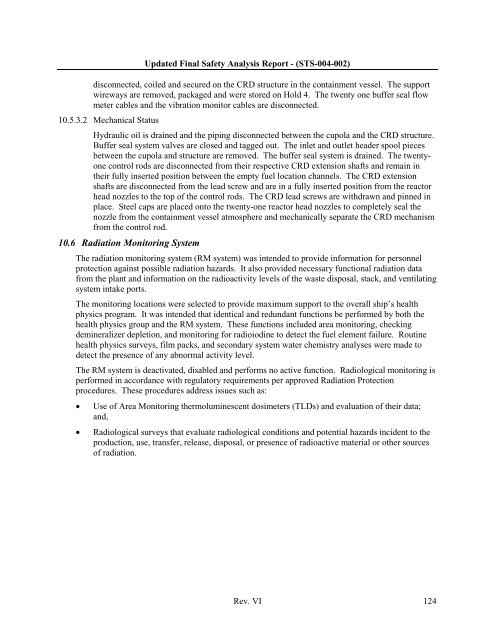10 CFR 50.71(e) - Maritime Administration - U.S. Department of ...
10 CFR 50.71(e) - Maritime Administration - U.S. Department of ...
10 CFR 50.71(e) - Maritime Administration - U.S. Department of ...
Create successful ePaper yourself
Turn your PDF publications into a flip-book with our unique Google optimized e-Paper software.
Updated Final Safety Analysis Report - (STS-004-002)disconnected, coiled and secured on the CRD structure in the containment vessel. The supportwireways are removed, packaged and were stored on Hold 4. The twenty one buffer seal flowmeter cables and the vibration monitor cables are disconnected.<strong>10</strong>.5.3.2 Mechanical StatusHydraulic oil is drained and the piping disconnected between the cupola and the CRD structure.Buffer seal system valves are closed and tagged out. The inlet and outlet header spool piecesbetween the cupola and structure are removed. The buffer seal system is drained. The twentyonecontrol rods are disconnected from their respective CRD extension shafts and remain intheir fully inserted position between the empty fuel location channels. The CRD extensionshafts are disconnected from the lead screw and are in a fully inserted position from the reactorhead nozzles to the top <strong>of</strong> the control rods. The CRD lead screws are withdrawn and pinned inplace. Steel caps are placed onto the twenty-one reactor head nozzles to completely seal thenozzle from the containment vessel atmosphere and mechanically separate the CRD mechanismfrom the control rod.<strong>10</strong>.6 Radiation Monitoring SystemThe radiation monitoring system (RM system) was intended to provide information for personnelprotection against possible radiation hazards. It also provided necessary functional radiation datafrom the plant and information on the radioactivity levels <strong>of</strong> the waste disposal, stack, and ventilatingsystem intake ports.The monitoring locations were selected to provide maximum support to the overall ship’s healthphysics program. It was intended that identical and redundant functions be performed by both thehealth physics group and the RM system. These functions included area monitoring, checkingdemineralizer depletion, and monitoring for radioiodine to detect the fuel element failure. Routinehealth physics surveys, film packs, and secondary system water chemistry analyses were made todetect the presence <strong>of</strong> any abnormal activity level.The RM system is deactivated, disabled and performs no active function. Radiological monitoring isperformed in accordance with regulatory requirements per approved Radiation Protectionprocedures. These procedures address issues such as:Use <strong>of</strong> Area Monitoring thermoluminescent dosimeters (TLDs) and evaluation <strong>of</strong> their data;and,Radiological surveys that evaluate radiological conditions and potential hazards incident to theproduction, use, transfer, release, disposal, or presence <strong>of</strong> radioactive material or other sources<strong>of</strong> radiation.Rev. VI 124
















